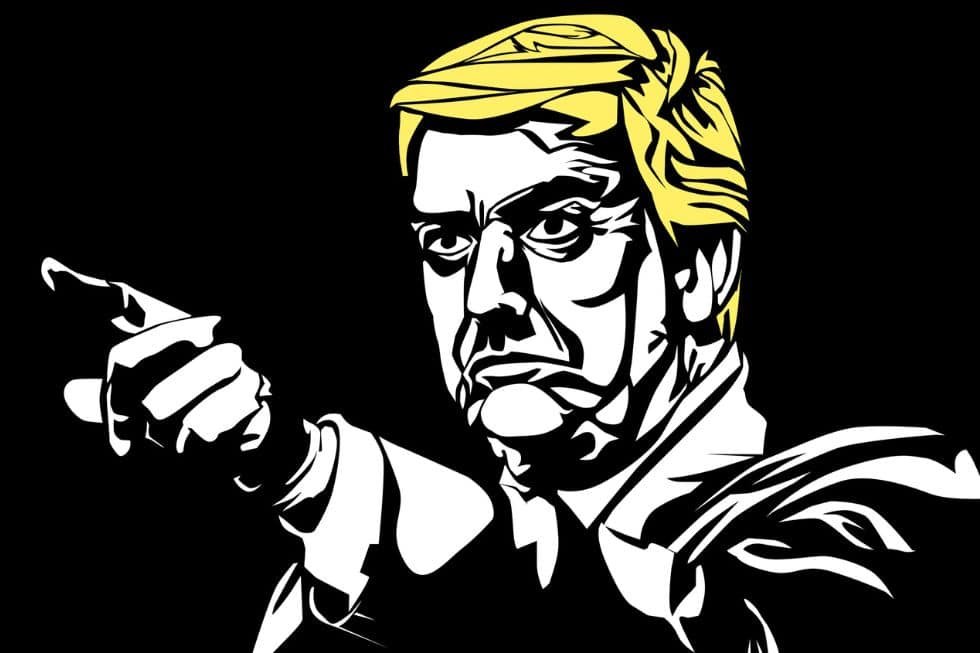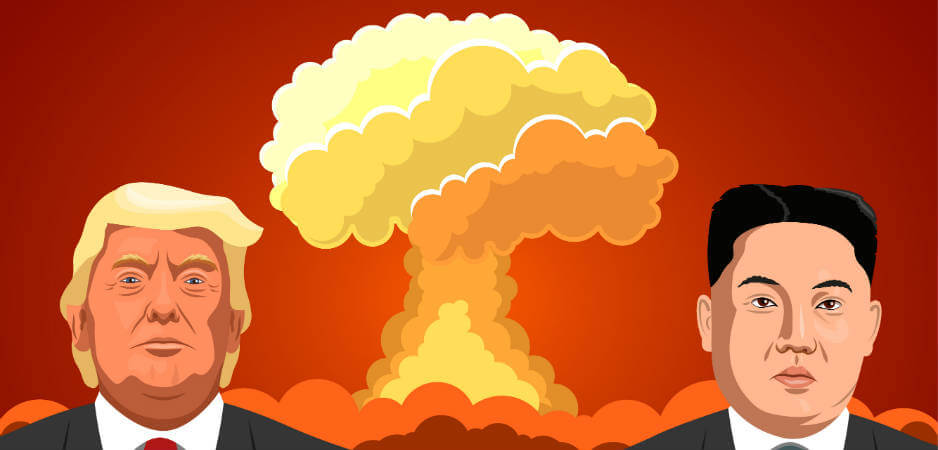Friends and acquaintances who have discovered my recent identity as Devil’s Advocate at Fair Observer increasingly ask me to weigh in on a question they seem obsessed with: Can a devil be elected to serve in the White House? Given the havoc Trump creates whenever he speaks or acts, their curiosity is understandable. Many appear convinced Trump is the embodiment of evil, an American Prince of Darkness.
In other words, they would like me to use this column to declare officially that the current president of the United States is either the Devil himself, a bona fide member of Satan’s cohort or, at the very least, worthy of being publicly recognized as one through a process mirroring the canonization of a saint. I remind them that the business of a Devil’s Advocate only concerns dossiers for sainthood, not demonhood.
At first I resisted, but I must admit that I increasingly find the question compelling. Therefore, though I honestly consider it outside the realm of physical or even metaphysical possibility — since among living humans there is clearly no consensus that devils even exist — I’ve decided to review the available evidence for the case concerning Trump’s possible demonic identity.
What’s in the dossier concerning Trump’s devilry?
Most of the plaintiffs who have brought my attention to the case highlight what they call Mr. Trump’s “fascist tendencies.” A nation whose military is now called upon to wage war on its major cities at some point stops resembling a democracy. On that score, they have good reason to highlight Trump’s treatment of two statistically significant classes of people the president clearly wishes to either exile or suppress.
The first category includes individuals whose cutaneous pigmentation is neither Caucasian nor African, but somewhere in between. They are usually referred to as “brown” and represent approximately 20% of the current American population. Their facial and morphological traits suggest traces of Native American ancestry and family origins linking them to Spanish-speaking American nations. My friends typically refer to them as Hispanics, Latinos or (the silliest among them) Latinx. Trump has spent a lot of energy and resources reinforcing an arm of government called Immigration and Customs Enforcement (ICE) to arrest, manhandle, bully, intimidate or deport them. ICE was originally created in the wake of September 11 when US President George W. Bush’s administration took a major step in installing xenophobic paranoia as a permanent feature of the logic and culture of the federal government.
The second category includes people of any race or origin who publicly (and even privately) convey messages indicating disapproval of policies, actions or attitudes manifested by or associated with the state of Israel. Washington is fair game (to some extent), but Tel Aviv is sacred. NDTV World quotes US District Judge William Young in saying: “the Trump administration targeted non-citizen students backing the Palestinians as the war in Gaza grinds on, with the ‘goal of tamping down pro-Palestinian student protests and terrorizing similarly situated’ students.”
Concerning the first category, the Hispanics, Trump appears to believe that they do not qualify as archetypical “Americans,” despite the fact that most have bloodlines reaching far back in history to a period before the first Europeans had even set eyes on the New World. (Note that I’m using the term “American” inaccurately, following traditional practice. Instead of designating a continent, we have been told that “America” should refer exclusively to the United States of America).
For Trump, true Americans are easy to identify. They have similar sounding names, such as Vance, Drumpf, Jones, Petitbon, Macgregor, Stevenson, O’Neill, Rosenfeld, Barzetti, Van de Camp, Kowalski, Johanson. In other words, a similar style of name that so clearly connotes a people with a common origin and shared culture. Cutaneous pigmentation (or a paucity of it), we should be reminded, has nothing to do with defining this perfectly unified group. Why should it?
To put it more bluntly, as Trump sees it, there’s already enough diversity just among white people, meaning there’s no need in such a broadly inclusive system to so much as think of adding supplementary colors when seeking to define what it means to be American. It’s been hard enough bringing together all those varied people of European extraction. Inclusion and diversity have their merits, but like any good thing, one must never overdo it.
It isn’t just about race
The reasoning doesn’t stop there. Trump has consistently reminded us that there are totally pragmatic reasons to seek to exclude a lot of the darker-hued people. Terrorism and narcotics trafficking, for example. Trump is now using these criteria with increasing aggression as the means of preventing random South Americans in speedboats from getting anywhere near the US coastline. If they’re speeding they must be terrorists or narcotraffickers, or preferably both.
J. Michael Luttig, writing for The Atlantic, complains that “Trump has turned the federal government against the American people, transforming the nation’s institutions into instruments for his vengeful execution of the law against honorable citizens for perceived personal and political offenses. He has silenced dissent by persecuting and threatening to prosecute American citizens for speaking critically of him, and he has divided us, turning us against one another so that we cannot oppose him.”
Most observers would classify such a political attitude as neo-fascist if not simply fascist. But the complaints include more than just the pressure on US citizens. My friends cite other factors that could lead us to qualify Trump’s policies as resembling the classic fascism of Italy and Germany in the last century. For example, in January, Trump began talking about invading and conquering Panama and Greenland, as well as annexing Canada. It’s difficult not to see a resemblance with Adolf Hitler’s ambition to extend Germany’s Lebensraum. Journalist and geopolitical analysis Ben Norton on Geopolitical Economy Report describes the broader implications: “The Donald Trump administration seeks to forcibly impose the US empire’s hegemony in Latin America. While hypocritically using “war on drugs/terror” rhetoric, it is reviving the colonial Monroe Doctrine, which top officials now call the Donroe Doctrine.”
One of the diabolical traits of political personalities associated with fascism that people like to highlight is their appetite for killing for the sake of killing, including a delight in the numbers of people they are willing to sacrifice. Israeli Prime Minister Benjamin Netanyahu has built up a solid case, successfully prosecuted at the International Criminal Court, for designating him as a sanguinary, genocidal sadist who, in a world that believed in justice, would not be allowed to walk the streets, let alone govern a nation. But does Trump live up to that image?
During a press conference last week, Trump explained why declaring war made no sense when one can simply “kill people that are bringing drugs into our country. OK. We’re gonna kill them. They’re going to be, like, dead.” To some people that sounds even more diabolical than the genocidal programs of Hitler and Netanyahu. After all, those two villains carefully “reasoned” their campaign, which they conceived as a scientific plan destined to fulfill their own perverse vision of a world that reflected their understanding of their role in history as the master race, in one case, and the chosen people, in the other. Trump’s delight in killing isn’t ideological, religious or even nationalistic. It appears as something personal, symbolizing his power over life and death.
Devils or monsters?
I have to admit that the case for branding Trump as an incarnation of the devil seems superficially attractive. But for the moment I don’t find it totally convincing. A better case for demonic identity could be made for what some call the “technofascists” of Silicon Valley. They’re a select group that have assumed greater power over the world’s population than any US president. That makes sense since any president may disappear from the scene at four-year intervals, at least under the current constitution. The technofascists, all of whom exhibit different degrees of diabolical intent, have names like Peter Thiel, Alex Karp and Elon Musk. Their ambitions are quite literally cosmic as Thiel is ready to sanguinelty envision the end of humanity and Musk is convinced that humanity, lacking both his intelligence and especially wealth, isn’t ready for the coming catastrophe, for which only he has the answer. Unlike Trump, these people actually spend massive amounts of money on recrafting the world and even the universe to make it conform to their vision.
It doesn’t matter that they do such things in the framework of a political democracy. The people have no say concerning their influence and decision-making and no access, other than as passive users, to the tools they control. Politics, even at Trump’s level, cannot compete with the technofascists with regard to the capacity for evil.
Former New York Times and now independent journalist Patrick Lawrence just this week called out the moral failure of the Trump administration with regard to Israel’s genocidal war on Gaza. He compared their insensitivity and moral cowardice to the bold stance of Ireland’s newly-elected president, Catherine Connolly, who has not hesitated to call Israel a “terrorist state.” “The president, Marco Rubio, Pete Hegseth, Steve Witkoff, Jared Kushner, and the others on Trump’s foreign policy ‘team’ are by comparison monsters diametrically out of touch with the world, the zeitgeist, of another time, of another cause—a cause other than the human cause.”
At this point, terming such people “monsters” seems to me more appropriate than devils. Monsters appear threatening because of their sheer force and physical capacity to do harm. But is all harm evil? The monsters are what they are, and some may exist to do harm, but “evil” is about intentions, not just force. Think of Frankenstein’s monster or King Kong.
The reason politicians who endorse harmful policies are monsters and not devils is that, like Frankenstein’s monster, they execute the program that has been devised for them by people who have decided to play with evil, whether their specific intention is to wreak evil or not. Trump is a special case. Nothing he does is inconsistent with the institutions that he has under his full or partial control: the military, intelligence and the executive branch of the US government. He didn’t invent the logic of a system that has been built over decades, if not centuries, to exploit and rule the nation’s resources and, increasingly over time, the world’s resources.
Trump merely has a more frank and openly aggressive way of doing it and making it more visible. Doing the bidding of Israel, for example, has been the game that every president since Lyndon B. Johnson has embraced and played with increasingly high stakes. Provoking wars around the world and supporting the “allies” (puppets) who are sacrificing their populations in those wars is not a practice Trump invented.
For the moment, let’s prefer to call Trump a monster. The case for his demonic identity remains to be examined.
[The Devil’s Advocate pursues the tradition Fair Observer began in 2017 with the launch of our “Devil’s Dictionary.” It does so with a slight change of focus, moving from language itself — political and journalistic rhetoric — to the substantial issues in the news. Read more of the Fair Observer Devil’s Dictionary. The news we consume deserves to be seen from an outsider’s point of view. And who could be more outside official discourse than Old Nick himself?]
[Lee Thompson-Kolar edited this piece.]
The views expressed in this article are the author’s own and do not necessarily reflect Fair Observer’s editorial policy.
Support Fair Observer
We rely on your support for our independence, diversity and quality.
For more than 10 years, Fair Observer has been free, fair and independent. No billionaire owns us, no advertisers control us. We are a reader-supported nonprofit. Unlike many other publications, we keep our content free for readers regardless of where they live or whether they can afford to pay. We have no paywalls and no ads.
In the post-truth era of fake news, echo chambers and filter bubbles, we publish a plurality of perspectives from around the world. Anyone can publish with us, but everyone goes through a rigorous editorial process. So, you get fact-checked, well-reasoned content instead of noise.
We publish 3,000+ voices from 90+ countries. We also conduct education and training programs
on subjects ranging from digital media and journalism to writing and critical thinking. This
doesn’t come cheap. Servers, editors, trainers and web developers cost
money.
Please consider supporting us on a regular basis as a recurring donor or a
sustaining member.
Will you support FO’s journalism?
We rely on your support for our independence, diversity and quality.











Comment